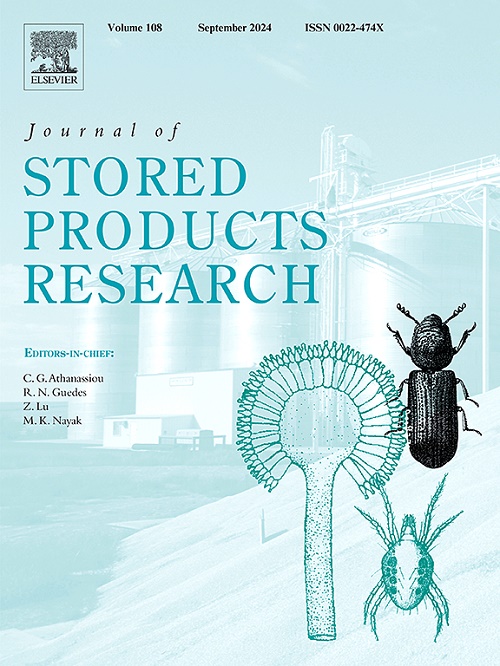Temperature mediates life history, energy reserves, and host selection of Trogoderma granarium Everts (Coleoptera: Dermestidae)
IF 2.7
2区 农林科学
Q1 ENTOMOLOGY
引用次数: 0
Abstract
We examined how diet and temperature affect developmental time and survival of immature stages, adults’ longevity, fecundity, and energy reserves of Trogoderma granarium Everts (Coleoptera: Dermestidae), a cosmopolitan pest of grains and other stored products. Also, we studied whether and to what extent the temperature impacts the host selection by larvae. Beetles were reared under five temperature regimes (21, 25, 29, 33, and 37 °C, 65 ± 5% R.H. and a photoperiod of 14L: 10D h) and fed with three commodities (barley, walnut, and wheat). At 29, 33, and 37 °C, the shorter immature developmental time and higher survival rate of T. granarium were on wheat, followed by barley and walnut. A diapause-like state was induced in the last instar larvae fed barley at 25 and 21 °C and wheat at 21 °C. In contrast, the beetles fed walnut completed their life cycle and successfully oviposited at these temperatures. At 21 and 25 °C, walnut attracted a higher density of larvae in a free-choice condition. Conversely, wheat attracted more larvae at 29, 33, and 37 °C, and the lowest number of larvae was observed on walnut. The walnut-fed larvae had a higher content of lipids than wheat- and barley-fed larvae. The present study highlights the need to account for temperature effects when studying the food preferences of insects and to consider further characteristics that may impact host selection. Our findings allow us to anticipate the population dynamics of T. granarium on different commodities according to environmental temperature.
求助全文
约1分钟内获得全文
求助全文
来源期刊
CiteScore
5.70
自引率
18.50%
发文量
112
审稿时长
45 days
期刊介绍:
The Journal of Stored Products Research provides an international medium for the publication of both reviews and original results from laboratory and field studies on the preservation and safety of stored products, notably food stocks, covering storage-related problems from the producer through the supply chain to the consumer. Stored products are characterised by having relatively low moisture content and include raw and semi-processed foods, animal feedstuffs, and a range of other durable items, including materials such as clothing or museum artefacts.

 求助内容:
求助内容: 应助结果提醒方式:
应助结果提醒方式:


